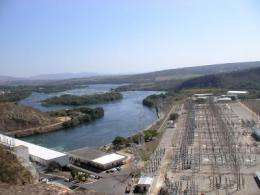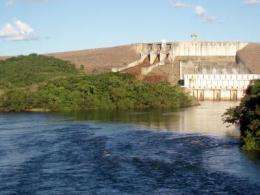Greenhouse gas impact of hydroelectric reservoirs downgraded

An international team of scientists has amassed the largest data set to date on greenhouse gas emissions from hydroelectric reservoirs. Their analysis, published today in the online version of Nature Geoscience, posits that these human-made systems emit about 1/6 of the carbon dioxide and methane previously attributed to them.
Prior studies based on more limited data cautioned that hydroelectric reservoirs could be a significant and large source of both carbon dioxide and methane to the atmosphere.
Through an analysis of 85 globally-distributed hydroelectric reservoirs, the authors revealed that these systems emit 48 million metric tons of carbon annually, a downgrade from earlier estimates of 321 million metric tons. Further putting things in perspective, hydroelectric reservoirs are responsible for less than 16% of the total carbon dioxide and methane emissions from all types of human-made reservoirs combined.
"Our analysis indicates that hydroelectric reservoirs are not major contributors to the greenhouse gas problem," comments Dr. Jonathan Cole, a limnologist at the Cary Institute of Ecosystem Studies and one of the paper's authors. "But there are some caveats. To date, only 17% of potential hydroelectric reservoir sites have been exploited, and impacts vary based on reservoir age, size, and location."

Carbon dioxide and methane are two of the main greenhouse gases created by human activities. Carbon dioxide is produced during the combustion of nearly any organic material; methane has a variety of industrial sources. Both gases are also produced naturally, particularly in wetlands and lakes.
When rivers are dammed to make the reservoirs needed for hydroelectricity, flooding creates lake-like conditions that generate carbon dioxide and methane. Emissions are the highest following reservoir construction, due to decomposing vegetation and soil organic matter. As reservoirs age, emissions decline, with cold-water systems stabilizing more rapidly than their warm-water counterparts.
Lead author MSc. Nathan Barros, of the Federal University of Juiz de Fora further explains, "The bottom line is that per unit of energy, hydroelectric generation produces much less carbon dioxide and methane emissions than previously thought, but impacts are not equal across all landscapes."
The amount of greenhouse gases generated by hydroelectric reservoirs depends on where they are built, with the team's analysis indicating that emissions are correlated with latitude and the amount of biomass in the watershed. With Barros adding, "Reservoirs in tropical locations, such as the Amazon, emit more methane and carbon throughout their lifecycles."
Hydroelectricity supplies an estimated 20% of the world's electricity and accounts for more than 85% of electricity from renewable sources. Future development is expected globally.
The paper's authors urge careful consideration of site location and design. "During the environmental impact phase, it should be a goal to minimize the amount of carbon dioxide and methane emitted per unit of energy generated," Cole notes.
To truly tease apart the emissions generated by hydroelectricity, the authors also call for a study that assesses a site's carbon budget before and after reservoir construction. Pre- and post flooding analysis would clarify the net carbon impact of hydroelectric reservoirs.
Provided by Cary Institute of Ecosystem Studies















